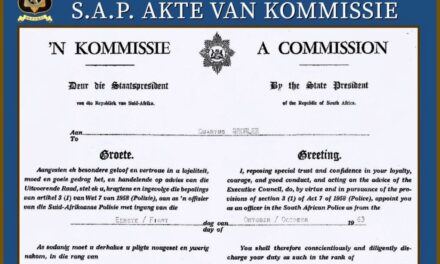SOUTH AFRICAN COMMONWEALTH WAR CASUALTIES BURIED ACROSS THE WORLD: PART SEVENTY-ONE
ABSTRACT: Thirty South African casualties from the Second World War are buried in the Cassino War Cemetery. Foiano Della Chiana War Cemetery contains 256 Commonwealth burials of the war. Ploegsteert Memorial commemorates more than 11,000 servicemen from the First World War, 289 of the burials are unidentified.Within the cemetery stands the CASSINO MEMORIAL which commemorates over 4,000 Commonwealth servicemen who took part in the Italian campaign whose graves are not known. Forty seven South African casualties from the Second World War are buried in this cemetery. Authuile Military Cemetery, FranceThe village was held by British troops from the summer of 1915 to March, 1918, when it was captured in the German Offensive on the Somme; it was ruined by shell fire even before that date.The Military Cemetery was used by Field Ambulances and fighting units from August, 1915 to December, 1916, and in 1917 and 1918 by Indian Labour Companies.The graves of two other German soldiers have been removed.The cemetery covers an area of 2,650 square metres and is enclosed by a low concrete curb.
KEYWORDS: cemetery, from, war, casualties, buried, south africa, world, memorial, military, Cassino War Cemetery,Foiano Della Chiana War Cemetery, Italy, Ploegsteert Memorial Belgium, Forli War Cemetery Italy, Battle of Aubers Ridge, Authuile Military Cemetery
AUTHOR: Capt Charles Ross (SA Navy) (Retired)
Foiano Della Chiana War Cemetery – Italy
On 3 September 1943 the Allies invaded the Italian mainland, the invasion coinciding with an armistice made with the Italians who then re-entered the war on the Allied side.
Progress through southern Italy was rapid despite stiff resistance, but the advance was checked for some months at the German winter defensive position known as the Gustav Line. The line eventually fell in May 1944 and as the Germans withdrew, Rome was taken by the Allies on 3 June.
Early in July there was heavy fighting in the Chiana valley where the Germans made their last stand in front of Arezzo and the Arno. The cemetery is a battlefield cemetery originally formed by the 4th Division and later increased when graves were brought in from the surrounding area. Most of the burials in the cemetery date from the first two weeks of July 1944.
Foiano Della Chiana War Cemetery contains 256 Commonwealth burials of the Second World War. It was designed by Louis de Soissons.
There are 66 South African casualties from the Second World War buried in the cemetery.
Ploegsteert Memorial – Belgium
The PLOEGSTEERT MEMORIAL commemorates more than 11,000 servicemen of the United Kingdom and South African forces who died in this sector during the First World War and have no known grave. The memorial serves the area from the line Caestre-Dranoutre-Warneton, in Belgium, to the north, to Haverskerque-Estaires-Fournes, in France, to the south, including the towns of Hazebrouck, Merville, Bailleul and Armentieres, the Forest of Nieppe, and Ploegsteert Wood. The original intention had been to erect the memorial in Lille.
Most of those commemorated by the memorial did not die in major offensives, such as those which took place around Ypres to the north, or Loos to the south. Most were killed in the course of the day-to-day trench warfare which characterised this part of the line, or in small scale set engagements, usually carried out in support of the major attacks taking place elsewhere.
It does not include the names of officers and men of Canadian or Indian regiments (they are found on the Memorials at Ypres, Vimy and Neuve-Chapelle) and those lost at the Battle of Aubers Ridge, 9 May 1915, who were involved in the Southern Pincer (the 1st, 2nd, Meerut and 47th Divisions – they are commemorated on the Le Touret Memorial).
13 South African casualties from the First World War are commemorated on this memorial..
Forli War Cemetery – Italy
On 3 September 1943 the Allies invaded the Italian mainland, the invasion coinciding with an armistice made with the Italians who then re-entered the war on the Allied side.
Following the fall of Rome to the Allies in June 1944, the German retreat became ordered and successive stands were made on a series of defensive lines. In the northern Apennine mountains the last of these, the Gothic Line, was breached by the Allies during the Autumn campaign and the front inched forward as far as Ravenna in the Adratic sector, but with divisions transferred to support the new offensive in France, and the Germans dug into a number of key defensive positions, the advance stalled as winter set in.
The cemetery site was selected soon after the Eighth Army took Forli in November 1944 and graves were brought into it from the surrounding battlefields. Many of those buried there lost their lives in the heavy fighting between Rimini and Ravenna which took place in appalling weather in October-December 1944.
Forli War Cemetery contains 738 Commonwealth burials of the Second World War, 4 of which are unidentified.
30 South African casualties from the Second World War are buried in this cemetery.
Cassino War Cemetery – Italy
On 3 September 1943 the Allies invaded the Italian mainland, the invasion coinciding with an armistice made with the Italians who then re-entered the war on the Allied side.
Progress through southern Italy was rapid despite stiff resistance, but by the end of October, the Allies were facing the German winter defensive position known as the Gustav Line, which stretched from the river Garigliano in the west to the Sangro in the east. Initial attempts to breach the western end of the line were unsuccessful. Operations in January 1944 landed troops behind the German lines at Anzio, but defences were well organised, and a breakthrough was not actually achieved until 18 May, when Cassino was finally taken.
The site for CASSINO WAR CEMETERY was originally selected in January 1944, but the development of the battle during the first five months of that year made it impossible to use it until after the Germans had withdrawn from Cassino. During these early months of 1944, Cassino saw some of the fiercest fighting of the Italian campaign, the town itself and the dominating Monastery Hill proving the most stubborn obstacles encountered in the advance towards Rome. The majority of those buried in the war cemetery died in the battles during these months.
There are now 4,271 Commonwealth servicemen of the Second World War buried or commemorated at Cassino War Cemetery. 289 of the burials are unidentified.
Within the cemetery stands the CASSINO MEMORIAL which commemorates over 4,000 Commonwealth servicemen who took part in the Italian campaign whose graves are not known.
The CEMETERY and MEMORIAL were designed by Louis de Soissons.
47 South African casualties from the Second World War are buried in this cemetery.
Authuile Military Cemetery – France
The village was held by British troops from the summer of 1915 to March, 1918, when it was captured in the German Offensive on the Somme; it was ruined by shell fire even before that date.
The Military Cemetery was used by Field Ambulances and fighting units from August, 1915 to December, 1916, and in 1917 and 1918 by Indian Labour Companies.
There are now over 450, 1914-18 war casualties commemorated in this site. Of these, nearly 40 are unidentified and special memorials are erected to 18 soldiers from the United Kingdom, known or believed to be buried among them. The graves of two other German soldiers have been removed.
The cemetery covers an area of 2,650 square metres and is enclosed by a low concrete curb. The cemetery was named as Authuile Military Cemetery at the time of creation and C.W.G.C. maintain this as the historic name of the cemetery.
Three South African casualties from World War One are buried in this cemetery.











